Elemental Cycle – Pack 6 – Elements Unbound

We finally have the last pack in the elemental cycle Pack 6 – Elements Unbound. Where the previous packs focused on one of the 5 elements, this pack appears to focus on the problems Rokugan has recently had with the elemental kami rebelling and causing trouble.
101. Hisu Mori Toride
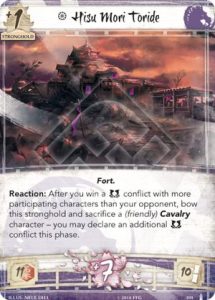
The Unicorn and Lion are currently at war for control of Hisu Mori Toride, so a stronghold for each clan that shares a name and a broadly similar effect makes for a pretty neat way to represent this. There are some differences though, which we think the Unicorn are going to be much happier about. To start with, the Unicorn version of Hisu Mori Toride (hereafter UHMT), exchanges a point of province strength for one additional influence. While neither of these values may have an impact during a specific game (your opponent may not reach your stronghold, or you may not draw the card you spent your additional influence on), the implications of the additional influence are much greater, offering a wider range of deck-building options. Province strength can matter (and when it does, it really does), but the additional influence can and will alter the very fabric of the decks coming out of UHMT.
Next, we have the ability. Whereas LHMT relies on winning a military conflict by 5 to trigger its ability, UHMT requires that you outnumber your opponent during a military conflict. On the face of it, UHMT may seem to have the more restrictive requirement, but cards like Force of the River, Shiksha Scout, Moto Nergui, Moto Juro, Dispatch, and others, give the Unicorn unparalleled control of the outnumbering game, while Lion remain vulnerable to many standard defensive measures. Unicorn also do not have to spend influence on Captive Audience to transform any conflict into military, and have Shiotome Enchampment as both an economic multiplier and major tempo tool. All in all, UHMT appears to outclass LHMT in almost every capacity, with synergistic tools and a more complete vision for its design.
The implications UHMT has for the environment are far-reaching. While LHMT remains peculiarly vulnerable to Scorpion’s standard box of defensive tricks, UHMT may present an almost intractable problem. Its strength (outnumbering) lines up directly against one of Scorpion’s (minimal board presence) and appears to trump it, at least sufficiently to guarantee getting its additional conflict. By continually pushing multiple conflicts, Unicorn have the very real possibility of blunting Scorpion’s defensive edge. Scorpion players may be able to adapt to this of course, but if they’re forced to make major changes, this is almost guaranteed to have huge knock-on implications for the rest of the metagame. Scorpion have lacked a natural predator, and by attacking along a completely new axis, UHMT may prove to be just that.
It can be rightly argued that Unicorn required an enormous jolt of power to bring them up to par, which the Elemental Cycle appears to have achieved. Just how far up the tier rankings Unicorn go remains to be seen, but UHMT is the lynchpin that all the other Unicorn cards have been waiting for. Hopefully, the long purgatory of the Unicorn Clan is now officially over.
102. Magistrate Station

The Crane Clan hasn’t had a lot to cheer about through this cycle, but thankfully the last pack may raise a couple of smiles. Magistrate Station is a 3-strength fire province with one of the most powerful abilities in the game – that of straightening a character. Being Crane, though, only the best will do, so it is restricted to targeting honored characters. However, that is hardly a concern. Crane have so many ways to honor their people that the Station should never lack for targets. One of the peculiar twists for this card is that it’s a province. As a holding, it would have been truly amazing, and arguably way overpowered – and, again, we have to look at Guest of Honor as the probable reason why. An honored Guest combined with Magistrate Station can lock an opponent out of events for half the conflict phase, so the added variance of possibly never seeing this card – should your opponent never attack it – is an almost necessary balancing requirement. And this is why having broken cards isn’t always a good thing. That said, if a Crane player flips and successfully defends their Magistrate Station, it presents a huge value and tempo boost, further compounding the benefits of being honored into a potentially game-deciding edge. Crane players will have to sacrifice their current fire province (if they play one) to include this, but Magistrate Station’s capacity to dominate a board seems more than worth the trade.
103. Web of Lies

There are some scenarios in which Web of Lies can be impressive – e.g., your opponent’s first few attacks in the game, or a Maze of Illusion played in a clutch battle to jump from 2 province strength to 10. But by playing this you are choosing to gamble that it will be high when you need it to be, or that you’ll be able to manipulate it when required.
Unfortunately, the flow of a game means that the ideal place for this is your stronghold, since you don’t want your opponent to be able to farm it for rings in the early game, and then, often, by the time you are forced to defend your stronghold, you are down to bidding 1 or 2. 8 or 10 province strength can be nice, but it’s unlikely to be worth the risk that your opponent duels you, or your honor forces a low bid for the last battle and you’ve instead got a blank 2 or 4 province-strength province. There are enough good provinces in the game, even in water, that it’s not worth gambling this will be 8+ strength when you need it.
104. Yasuki Broker

Yasuki Broker is another Crab combo piece that’s pretty understatted, and has 2 glory that’ll hurt way more than it’ll ever help. But she has the Courtier trait (Crab’s second courtier!) and a really powerful ability. Along with Kuni Lab, Yasuki Broker is part of the upcoming Crab weenie deck. The goal of the deck is to attack and defend with your weenie hoard early, then, on the 3rd or 4th conflict of the game, attack or defend with the Yasuki Broker and start sacrificing your characters. Funeral Pyre for 2 cards and a fate! Miya Mystic for discarding an attachment, a card and a fate! Activate Tainted Hero for a card and a fate! And, combined with Yasuki Taka – she is going to make it rain. While appearing over-costed, she is actually incredibly exciting, and promises to be the engine that drives a new kind of Crab deck.
105. Tengu Sensei
Tengu Sensei is another powerful denial option to add to Crane’s arsenal. In a clan that skews toward political, it’s also a militarily-skilled character, which presents additional value considerations.
Although well understatted for its 5 cost, the Tengu Sensei‘s Covert keyword, combined with its ability, makes it one of the most devastating attackers in the game. A character Coverted by the Tengu cannot attack for the rest of the phase, making that character almost useless. This ability has different implications, depending on whether the Crane player is first. As first player, the Crane will have their choice of targets – most likely choosing the biggest offensive threat their opponent controls. The higher the cost of the affected character, the bigger the value swing. As second player, a Crane with Tengu Sensei on the board can expect their opponent to attack with their most important character straight away. The value of this is more context-dependent, but at they very least it takes a decision away from your opponent and may force them into an uncomfortable position.
Ironically, because so much of Tengu Sensei‘s power comes from Covert, Covert is one of its greatest weaknesses, since a character with Covert is entirely immune to it. So watch out for those Tattooed Wanderers. The Tengu Sensei is also non-unique, which means it is vulnerable to an inopportune Karmic Twist. Conversely, Tengu Sensei is non-unique – so you can have more than one of this bird on the table at a time. If this happens, and an opponent has no way of dealing with them, they will probably end the game, and even one Tengu on the board will represent huge problems for an opponent. Doji Hotaru is often considered one of the more underwhelming champions in the game, so the Tengu Sensei may usurp her as Crane’ go-to 5-cost character, alongside Kakita Yoshi.
106. Agasha Shunsen

Agasha Shunsen naturally draws comparisons to the Agasha Swordsmith. Both are Shugenja with similar stats who fetch attachments. At a glance, for an increased cost of 3 rather than 2 fate, Shunsen merely offers 1 higher glory. Not really an incentive. It does mean Shunsen is not vulnerable to Assassination, though, which is a constant worry when the Swordsmith enters play. With no benefit coming from his stats, we would then hope that Shensen’s ability is a little better. So, rather than looking at the top five cards with the Swordsmith, Agasha Shunsen can go search your entire deck to find the attachment he needs. Furthermore, you don’t need to pay the attachment’s fate cost to equip it! However, this comes with a pretty severe condition: you must return at least one of your claimed rings, and the attachment must cost equal to or less than the number of rings you return. In addition, his action can only be taken during a conflict. While an undeniably steep cost, returning a ring opens up one nice tactic: attack and claim a ring, then, during your opponent’s conflict, return the ring so you can attack and claim it a second time.
So, how does this work in practice? You can claim a ring on attack or defense; you just need to make sure you win the conflict. Therefore, claiming one ring should reliable enough. If you do so, then, during the next conflict, you can go through your deck for any attachment card you need that costs 0 or 1 fate. As the effect says ‘attach’ and not ‘play’, you get a minor cost saving in ignoring the cost of the attachment (unless we get a ruling to contradict that). Unfortunately, you can only target your own characters with Shunsen’s ability, so no easy Cloud the Mind or Hawk Tattoo on an enemy character. In addition, you can’t fetch any of the Dragon characters that can be played as attachments. Since the action has to be taken during a conflict, winning a ring during the last conflict will be of no use. This means that, at most, we’re looking at fetching a 3-cost attachment at the cost of returning all your rings. Although Shunsen is unique, Way of the Dragon and Togashi Yokuni do open up the possibility of using his ability multiple times in a turn, but that is also limited by the number of rings you can claim.
The big issue with his ability is losing the Imperial Favor. Dragon decks have leaned heavily on Censure and get a great bonus with Agasha Sumiko, so the Favor has become a key resource. Losing rings typically means losing the Favor and losing all of these options. For a deck that doesn’t focus on getting the Favor, however, Shunsen is a flexible card that lets you draw exactly the right attachment for one of your characters, and he may definitely find a place.
107. Kitsu Warrior
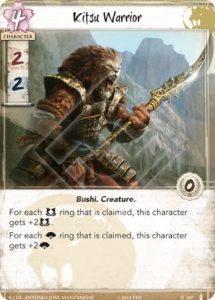
On the face of it, the Kitsu Warrior is one of the worst-statted cards in the game. In terms of stats:fate ratios, Lion seem to be on the receiving end of a lot of hate, since, with Kitsu Warrior, we now have three out of four of the least efficient 4-cost characters. The sole exception is Honored General, who remains a stellar character and a staple for Lion.
Kitsu Warrior, on the other hand, is about as close to a coaster as it gets (Ide Tadaji will make it out of binders before this card), and here is why:
- This character stinks in the first conflict, so that’s a write off.
- He is only skill-efficient in the third conflict of a turn, and only if at least two were military conflicts, AND you proc’d Hisu Mori Toride in one of them, AND you didn’t already need to commit this character to winning your first military conflict.
- If you are claiming rings and winning battles, you won’t need this card; you are winning already. This card will only help you win more. Never the sign of good card.
- If your opponent is claiming rings and winning battles, you are losing and this card is only going to help in one conflict, AFTER you have been beaten to within an inch of your life. Why deploy a telegraphed come-from-behind strategy when you could play a better character and proactively try to win?
The only scenario where this card makes an impact is when you bring it into play from Charge!, Ikoma Ujiaki or Kitsu Spiritcaller late in a turn, after a lot of rings have already been claimed. In this case, it can be a monster of a card, but the issue I have with this scenario is: why would you ever put cards in your deck that are only good in this scenario!? Fill your deck with cards that don’t RELY on specific scenarios and you will win far more games. The thing that irks me the most about this card, though, is the previous existence of Beastmaster Matriarch. The design team are pushing an agenda that players have already rejected en-masse. Where is the evolution in card design? Where is the progress? Lion are quickly becoming bottom-tier, because their card design is behind the curve, poorly balanced, and completely fractured in direction.
108. Reader of Omens
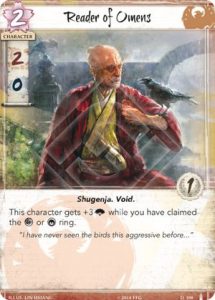
Phoenix’s addition to the ‘gains X skill if you control Y or Z rings’ characters is instantly forgettable. A blank 2/3 for 2 wouldn’t make it into current Phoenix lineups, so a conditional 2/3 for 2 definitely won’t. He should have read this card review and gotten better.
109. Reclusive Zokujin
In general, the assessment of many of the Scorpion characters in this cycle has been: “Potentially very good, but lack of Courtier means it may be hard to fit in the deck”. That is also true of the Reclusive Zokujin, but with one minor difference – it’s definitely going in the deck.
First, the main drawback of the card (other than the lack of Courtier) – only working during earth conflicts – isn’t really a drawback. Earth is, on average, the best ring in the game. Every other ring can offer a situationally better option, but it takes a cosmic alignment of factors for earth to not be worth resolving. You won’t always be able to capitalize on the Zokujin’s ability, but it will come up enough that it’s worth the risk.
If the Zokujin were a 1/3, it would be much less appealing. A large part of its strength lies in its being ‘off-stat’ for Scorpion. Being able to safely engage in a military conflict where the biggest defender can’t assign thanks to Covert, and in which you’re safe from most defensive actions is a big deal in a clan primarily oriented toward winning political conflicts. Even just the 3 military skill and Covert would be a strong combination (as we’ve seen with Unassuming Yojimbo), but the immunity to your opponent’s card effects is the delicious icing on the cake. And though not ideally used on defense, the Zokujin’s Covert and its ability make sure it can defend and guarantee that it will remain present for the whole Conflict. I fully expect this character to be one of the star Scorpions of the Elemental Cycle.
110. Minami Kaze Regulars

One of the issues Unicorn suffered from was a complete lack of quality top-end characters. With the arrival of the Minami Kaze Regulars, along with Shinjo Shono and Iuchi Shahai in earlier packs, we can now say this problem is over. The Regulars’ 6/3/2 stats are roughly on par with most champion-level characters at this cost. Their Cavalry trait is most welcome, and their ‘No attachments except Weapon‘ clause is a significant bonus in most cases, since it prevents Cloud the Mind. That said, Unicorn have access to a number of quality non-Weapon attachments, so it’s not always a benefit.
The Regulars’ ability is similar in many ways to Kudaka‘s – a Shugenja who’s been seeing a lot of play since her release. If the Regulars win a conflict and meet the outnumbering requirement that’s been a mechanical feature of the Unicorn throughout the Elemental Cycle, you gain 1 fate and draw a card. Even getting this ability off once effectively makes the Regulars a 4-cost 6/3 that draws you a card, and, should you resolve the reaction multiple times, the Regulars’ value skyrockets. With 6 military skill, they should dominate military contests, but their 3 political skill isn’t useless in a pinch, and their ability to threaten a meaningful political presence only to turn it into military rout with Captive Audience is not to be underestimated. They are non-unique, though, so watch out for Karmic Twists.
As a card with almost zero glaring weaknesses and some very glaring strengths, Minami Kaze Regulars will probably oust Shinjo Altansarnai from Unicorn decks. Altansarnai‘s ability offers less than it appears to, while the Regulars are almost guaranteed to generate value, and have a better skill split for what Unicorn will want to do post-Hisu Mori Toride.
111. Mantis Tenkinja

Continuing the Mantis theme of honor for fate, the Mantis Tenkinja offers a tempting prospect for any clan with a Water role. When you play an event, you can lose 1 honor to reduce the cost of that event by 1. While, in essence this maybe does little more than make the Tenkinja a 1/2/2 Shugenja for 1, the impact on the board can be far greater than it appears. With an active Tenkinja, a player can represent a far wider range of possible reactions and plays to an opponent, creating greater uncertainty and an analytical headache. As the game progresses, her impact will tend to lessen as resources accumulate, but with two factions now capable of declaring three conflicts per turn, players will be gaining fate less regularly from rings, so any economic advantage may prove important. And she’s clearly at her most impactful on turn 1, when resources are incredibly scarce and her ability represents a significant percentage of the game state’s total fate. Currently available only to Phoenix – a clan with notoriously fate-thirsty decks – she has every chance of breaking into their lineups. And, as other clans gain Water roles, she may well feature in those, too.
112. Awakened Tsukumogami

In Japanese folklore, Tsukumogami are tools that, after existing for a hundred years, gain a soul and become self-aware. In L5R, they’re a weird economy engine that won’t see any play. Currently, the list of cards the Tsukumogami affects are as follows (but if we’ve missed any, let us know):
- In Crane: The Mirror’s Gaze
- In Dragon: Smoke
- In Lion: My Ancestor’s Strength
- In Phoenix: Against the Waves, Clarity of Purpose, Consumed by Five Fires, Display of Power, Grasp of Earth, Ishiken Inititate, Kaito Kosori, Karmic Twist, Katana of Fire, Know the World, Seeker of Knowledge
- In Scorpion: Maze of Illusion, Yogo Kikuyo
- In Unicorn: Force of the River, Invocation of Ash, Iuchi Wayfinder
- Neutral: Cloud the Mind, Walking the Way
As we can see, the only two clans that would really consider the Tsukumogami are Unicorn and Phoenix. But Unicorn have a better enabler for two of their cards (Force and Invocation) in Iuchi Shahai, which means only Phoenix would consider this card. And Phoenix won’t consider this card, partly because it’s Void role only, and they can’t, and partly because it’s never going to make a return on its investment while offering nothing else of worth.
But the art is adorable.
113. Pragmatism
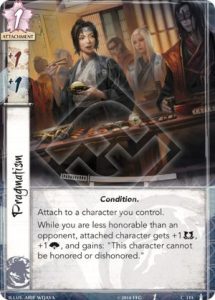
As a +1/+1 attachment for 1, Pragmatism is competing with a lot of good cards. Unfortunately, its upside is by no means equal to Watch Commander‘s. So, while you are on lower honor, Pragmatism gives its character an additional +1/+1 (for a total of +2/+2) and that character can’t be honored or dishonored. Basically – if you’re playing pragmatic Crab, this sometimes has the same stats as an appropriate Fan or Katana, and you can’t get hit by someone dishonoring you. It’s all right. It has some play in being tossed onto a rare 2-glory Crab going into a political conflict so your opponent can’t Court Games you, and if you’ve already managed to honor that character, they’ll stay honored until they leave play or lose the attachment. An active pragmatism does however make you vulnerable to effects like For Shame!, because you cannot select the dishonor option. If you can’t find a better card, you haven’t tried hard enough.
Small sidebar: Unlike Hawk Tattoo, Pragmatism cannot be played on an opponent’s character, which really makes you wonder about design’s priorities.
114. Specialized Defenses
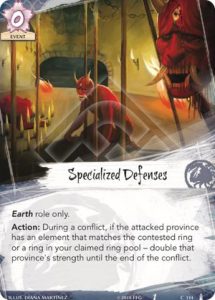
One Crab card a set will genuinely annoy me with how bad it is, and Specialized Defenses is this week’s winner. To explain why, we have to talk briefly about ‘role locking.’ Role locking is where a card is available only to a particular role, be it elementally locked or Seeker/Keeper locked. Role locking isn’t a problem – it’s an opportunity to put an above-the-curve card into an inherently limited space. Put a really strong removal action in Fire and one in Water and you don’t have to worry about someone combining the two in one deck. Or you might only want a certain type of effect available to a small pool of the environment. That’s all good design space. Clan-encrypting the roles, on the other hand, is an issue with the format too long to be discussed here. So, in brief, a role-locked card should be a powerful effect that needs to be silo’d away for some reason.
Let’s take a look at Specialized Defenses. On the plus side, it’s free. On the negative side, it requires an Earth role and then requires you to be defending a province whose element matches the contested ring or a ring in your claimed ring pool. To successfully pull off playing this card, you need to be carefully predicting your opponent’s target province, then grab the matching ring first, or steer your opponent into selecting the ring to match his target through careful fate play, or use Elemental Fury to make it Water when he attacks, or just randomly get lucky. What do you get for all this hard work? You double the provinces strength. Most of the time this equates to +4/5 province strength. The equivalent of playing a Banzai! on the defense.
On an attack into a province like Ancestral Lands with a big holding attached you might get a +12 province strength buff – but that’s really rare and it does nothing but save the province: your opponent will still get to resolve their ring. And even that level of return is painfully corner-case. If Specialized Defenses had some weaker effect when the province didn’t match, or did something crazy like claimed the ring if your opponent failed to take the province, I’d consider it. But as is it’s automatic binder fodder. Just terrible.
115. Mantra of Earth

Mantra of Earth, and mantra number three, is for the element of earth. It has similar requirements to the previous two, and draws a card as well. The effect appears quite powerful, since being immune to an opponent’s card effects provides a huge degree of assurance that you can at the very least contest – if not win – that particular conflict. However, any actions that could not be played due to Mantra of Earth will be playable in the next conflict. This means you’re only delaying the inevitable to a certain extent, but tempo considerations are valuable in this game. Furthermore, the Mantra feeds into the Monk mechanic of rapidly cycling your conflict deck, and all card draw effects reinforce all other card draw effects you have, so the cycling effect on its own is not to be underestimate. Mantra actions are also considered to be played during a given conflict, so they will help to power up Void Fist.
With a third mantra, the number of rings your opponent can safely declare reduces further, and Mantras themselves can be pretty great. They offer a completely free benefit with no downside. However, when your opponent doesn’t declare the right element, or you don’t have a Monk to target, they can sit dead in your hand. Never a good feeling. Playing Togashi Tadakatsu does make these Kihō a lot more consistent, but may also force you into giving your opponent a ring you’d rather they didn’t have, just to activate a mantra. But as long as you’re not necessarily attached to such worldly concepts as ‘value,’ you should be okay.
Mantra of Fire remains the mantra of choice, with a clear benefit. Mantra of Earth is easier to trigger than Mantra of Water, but doesn’t have as impactful an effect. While the mantras may seem like ‘fun’ cards, the sheer volume of card draw they can generate is not to be underestimated. What remains to be seen is whether somebody can focus them into a tournament-winning deck.
116. Being and Becoming

Being and Becoming is a super interesting attachment for a number of reasons. While bowing a character essentially takes them out of the game for a turn, if you have an action ability to straighten them, or win a water challenge as the attacker, the major downside of the card can be ameliorated. At its most basic, this card can be used to gain additional turns for a character by moving additional fate to them from a ring. If you were to do this for only 1 fate, you would essentially be trading one turn spent bowed turn for another turn in the future turn, which would, at best, be of extremely situational use. If you had a repeatable straighten effect, you could could use the ability each turn to top up your character with fate, but few such effects exist. To compare: Reprieve is a fantastic attachment costs 1 fate cost to essentially add 1 fate, and requires none of the hoop-jumping Being and Becoming demands. And Being and Becoming is also locked into the Void role, so there must be something more at play here.
And possibly there is. Being and Becoming has an extremely interesting interaction with Jurojin’s Curse. The Curse also is elemental locked to Void, so we can only assume this is intended. To play both cards, you need to be either Dragon and Phoenix, in addition to having a Void role. So, currently, no one can do this, but it’s really only a matter of time. If you have an unbowed character with both Being and Becoming and Jurojin’s Curse attached after Jurojin’s extra fate phase has occurred, you can then bow that character in the fate phase’s action window to move two fate from an unclaimed ring onto them. The double fate phase will mean that each ring will have at least two fate. By doing this, your character can stay in play for the rest of the game, assuming your opponent cannot kill them, triggering a double fate phase every turn.
There are a few more standard cases where Being and Becoming is worthwhile. Being able to keep a high-glory character around to contest the Imperial Favor every turn is pretty cool. Getting a little more fate onto your Niten Master can be good. Are those effects worth 2 fate and a card? Probably not, but this is definitely a card to keep an eye on.
117. Restored Heirloom

Water-role locked? Thanks… I’d rather resolve the water ring anyhow: its effect is more likely to have a lasting impact on the result of the game. Restored Heirloom is probably best in Phoenix, where declaring water conflicts is a priority early in the turn, and the low splash cost makes it a worthwhile inclusion as a 2-of. Being recursive is also neat for Phoenix, since you can happily attach this to a Fire Tensai Initiate and have a legitimate threat.
Lion has turned into a clan with a vast array of disparate “value establish” cards, when all others are receiving “value added” cards for already established themes and mechanics. The apparent lack of design direction for Lion provides cause for concern.
118. Roving Michibiku
Controlling certain rings can really help the Phoenix clan. Henshin Disciple, Ishiken Initiate, Katana of Fire, Solemn Scholar, and Isawa Tadaka all benefit, either directly or indirectly, from controlling certain rings. When an opponent denies those rings it can hurt, so now the Phoenix are employing roving gangs of ring-thieves to level things out. In truth, the Roving Michibiku is rarely going to benefit one of the above-mentioned cards, simply because only two of them see any regular play. But what the Michibiku does affect, which players vie for every turn, is the Imperial Favor. A 2-point swing in determining who claims the Favor should be enough to secure it in most cases, which can help to turn on powerhouses like Kanjo District, or activate Censure. As a Scholar, the Michibiku can enable Bustling Academy to do its thing, though his Monk trait is woefully under-supported in Phoenix, and would require a Dragon splash to make use of. As a 2/2/1 for 3, even as a conflict character, the Michibiku doesn’t offer fantastic skills, but he can be situationally powerful in concert with other cards.
119. Taryū-Jiai
Dueling Shugenjas! Since Taryū-Jiai is a glory-based duel, it is almost certain to see play exclusively out of Isawa Mori Seido. This is because glory has a much, much narrower range of value than military or political skills, so Isawa Mori Seido‘s ability will be needed to make the duel sufficiently one-sided. Even then, unless you have an Isawa Mori Seido-boosted Asako Azunami or Isawa Kaede against a 0-glory opponent, you will always need to bid at least 2 to guarantee a win. This narrows the card’s effectiveness, which is narrowed further by the requirement that your opponent is also playing Shugenja. This starts to stretch the list of what is needed to make good use of this card, although the reward – resolving a ring effect of your choice as if you were the attacker – is a major payoff. While this card would seem to suggest itself in Phoenix dishonor, or maybe honor, those archetypes are currently a mess, with four(!) different character traits (Bushi, Courtier, Monk, Shugenja) contributing differently, and all detracting from the focus required for a successful tournament build. As such, Taryu-Jiai doesn’t seem to have a natural home, which is a shame.

Unleash the Djinn offers an immensely powerful effect – at a price. By setting the military and political skills of each participating character to 3 until the end of the conflict – an effect which cannot be overridden except by another ‘set’ effect, and which overrides all attachments, and skill and honored/dishonored modifiers – Unleash the Djinn basically says that the player with the most units present wins the conflict. This can be especially devastating against clans like Lion and Scorpion, who tend to have very high skills in one area, at the cost of lacking them in the other. Unleash the Djinn can then effectively neutralize their innate advantages, turning the game into ‘who has more people’ as opposed to ‘whose are better.’ However, Unleash the Djinn is Fire role only, which severely restricts its availability, particularly to Unicorn, who have cards like Force of the River, which in combination with Unleash the Djinn, offer terrifying potential. The card does also cost you 3 honor, which can be extremely painful if it’s countered, and also almost precludes you from playing Assassination, or other cards with heavy dishonor costs, like Spreading the Darkness. Of the two clans who can play this at the moment – Dragon and Lion – Lion are much more likely to be able to generate the swarm-style that this card best rewards.
Summary
Crab get some interesting cards but nothing immediately of note. The Crane get Tengu Sensei who although expensive can negate an opponent’s character for a turn. The Dragon get Agasha Shunsen who has the potential to be very powerful, along with some other fun options. The Lion unfortunately don’t get much in this pack. Phoenix similarly get some interesting cards but nothing immediately that leaps out. Scorpion get Reclusive Zokujin, a dynasty side Unassuming Yojimbo. Unicorn of course are the big winners out of this pack if only for their version of Hisu Mori Toride. On the neutral side we get another good Mantis character with Mantis Tenkinja, unfortunately role locked again, but the Mantis fans will be delighted. Overall, not a very exciting pack ending the elemental cycle with a bit of a slump. Importantly, it does finally put Unicorn in a place where they finally can play like a great clan.
Check out the team going through the pack below:
This article was a team effort. All blame will be shared equally.
If you have any comments or feedback please post them in the comments section below. Join us on our Twitch stream every second Monday at 8pm BST, 9pm CEST, 1pm PST.
Check us out on the Imperial Advisor website, podcast, and YouTube channel for more discussion about the L5R LCG.





4 Replies to “Elemental Cycle – Pack 6 – Elements Unbound”
“By setting the military and political skills of each participating character to 3 until the end of the conflict – an effect which cannot be overridden…”
That’s not actually correct. It cannot be overridden EXCEPT by another ‘set’ effect.
Thanks for the timely and informative write-up, as always.
Cheers. Will edit that in.
I dont get where your getting your info from for the UHMT its plus one province strength plus one honor from old SH. Still same old 10 influence like everyone else right?
Btw love the reviews mostly good imsights i miss alot of times on my own.
We were comparing UHMT to LHMT.